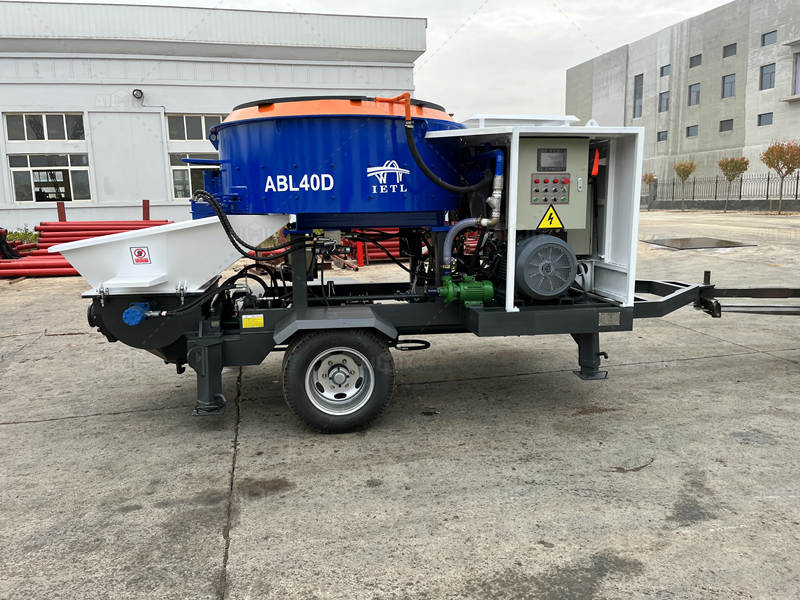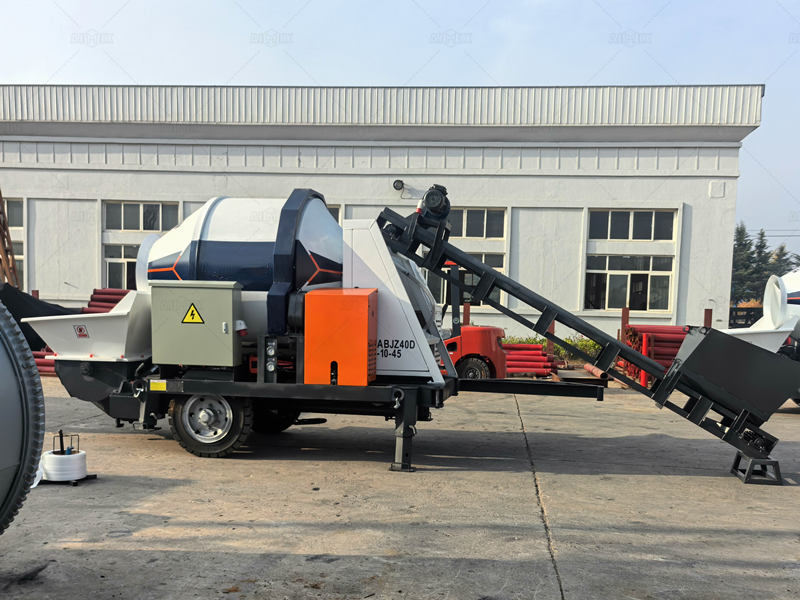The acquisition of combined equipment represents a significant investment for construction businesses, and understanding the relationship between machine specifications and cost is essential for making informed purchasing decisions. When evaluating concrete pumps for sale that integrate mixing and pumping functions, the concrete mixer with pump price is directly influenced by two fundamental engineering parameters: the volumetric capacity of the mixing system and the output performance of the pumping system. These technical specifications are not arbitrary figures but carefully engineered characteristics that determine the machine’s production capability, structural requirements, power needs, and ultimately its manufacturing cost and market value. The correlation between equipment scale and financial outlay becomes particularly evident when comparing various small concrete pumps for sale against their larger industrial counterparts, as each incremental increase in mixer volume or pumping capacity introduces corresponding escalations in material requirements, component robustness, power plant specifications, and technological complexity. This relationship between physical capacity and financial cost forms a predictable pattern across the market for concrete pumps for sale, where buyers can accurately estimate the concrete mixer with pump price based on these two critical performance metrics, enabling them to select equipment that precisely matches their operational requirements without overinvesting in excessive capability or underestimating their actual production needs.

Mixer Volume Capacity and Its Direct Cost Implications
The drum size of the integrated mixer represents one of the primary factors affecting the concrete mixer with pump price, as this specification dictates numerous downstream design requirements that collectively influence manufacturing expenses and final market valuation. Larger mixing drums naturally require more substantial construction materials, heavier-duty supporting frameworks, and more powerful rotation mechanisms, all of which contribute to increased production costs that manufacturers inevitably pass through to the final concrete mixer with pump price. When examining various small concrete pumps for sale, the compact mixing drums typically ranging from 3 to 6 cubic feet maintain affordability through their modest material requirements and simplified drive systems, whereas industrial-scale combination units with mixing capacities exceeding 20 cubic feet command premium pricing due to their heavy-duty construction and complex operational systems. The relationship between mixer volume and the concrete mixer with pump price follows a non-linear progression, meaning that doubling the drum capacity typically more than doubles the equipment cost due to the exponential increases in structural reinforcement, hydraulic power requirements, and chassis strengthening necessary to support the additional mass and operational forces. This fundamental connection between physical scale and financial valuation remains consistently observable across the entire spectrum of concrete pumps for sale, providing buyers with a reliable framework for anticipating cost variations between different models based solely on their mixing volume specifications.
Pumping System Performance Specifications
The pumping component of combination equipment represents another significant cost driver, with performance metrics such as maximum output volume, pressure capacity, and vertical/horizontal reach directly influencing the engineering complexity and consequent concrete mixer with pump price. Higher-capacity pumping systems capable of moving concrete at rates exceeding 60 cubic yards per hour require more robust hydraulic components, heavier-duty valves, and more powerful engines, all of which contribute to elevated manufacturing costs that translate to higher prices for these concrete pumps for sale. The maximum pressure rating of the pumping system, typically measured in bars or pounds per square inch, determines the equipment’s ability to convey concrete over substantial vertical heights and horizontal distances, with high-pressure systems incorporating more expensive components throughout the concrete pathway from the material cylinder to the delivery pipeline. When evaluating the concrete mixer with pump price, buyers will notice that models with identical mixing capacities but different pumping performance specifications carry significantly different price tags, reflecting the substantial cost differential between standard-pressure and high-pressure pumping components. This performance-based pricing structure becomes particularly evident when comparing various small concrete pumps for sale, where even modest increases in pumping capacity or pressure ratings produce noticeable escalations in the concrete mixer with pump price due to the precision engineering and durable materials required for reliable high-performance concrete conveyance.
Power Plant Requirements and Energy Consumption
The integrated nature of combination equipment necessitates a power source capable of simultaneously operating both mixing and pumping functions, with the combined power demand directly influencing engine specifications, fuel system capacity, and consequently the concrete mixer with pump price. Larger mixing drums and higher-capacity pumping systems require more powerful engines to generate the necessary torque for drum rotation and the hydraulic pressure for concrete conveyance, with each incremental increase in horsepower producing corresponding increases in manufacturing costs and final pricing for concrete pumps for sale. The selection between different power plant configurations, such as diesel engines, electric motors, or hybrid systems, introduces further variability in the concrete mixer with pump price, with diesel-powered models typically commanding premium pricing due to their more complex emission control systems and robust construction suitable for demanding construction environments. When examining small concrete pumps for sale, buyers will observe that even within this compact equipment category, significant price variations exist between models with different power ratings, reflecting the cost implications of more capable propulsion systems. Beyond the initial purchase price, the power plant specifications directly influence long-term operating expenses, with more powerful engines typically consuming greater amounts of fuel or electricity, though this ongoing operational cost represents a separate consideration from the initial concrete mixer with pump price that remains heavily influenced by the power system’s capabilities and complexity.

Structural Integration and Engineering Complexity
The successful combination of mixing and pumping functions within a single machine requires sophisticated engineering solutions that seamlessly integrate these distinct operational systems, with the complexity of this integration directly affecting manufacturing costs and the consequent concrete pump and mixer price. Combination equipment must balance the significant torsional forces generated by the rotating mixer drum with the substantial vibrational forces produced by the concrete pumping action, requiring reinforced frames, specialized mounting systems, and precision alignment that collectively contribute to higher production expenses. The concrete mixer with pump price further reflects the engineering investment required to develop control systems that coordinate the simultaneous operation of mixing and pumping functions, with more advanced computerized control platforms adding to the manufacturing cost but delivering superior operational synchronization. When comparing different concrete pumps for sale, the level of engineering sophistication becomes particularly evident in how seamlessly the equipment transitions between mixing and pumping modes, with more expensive models typically featuring smoother operational integration achieved through more complex hydraulic circuits and electronic control systems. This relationship between engineering complexity and equipment valuation remains consistently observable across the entire market spectrum, from basic small concrete pumps for sale to industrial-scale combination units, with each incremental improvement in operational integration and performance reliability producing corresponding increases in the concrete mixer with pump price that reflect the research, development, and precision manufacturing investments required to achieve these engineering advancements.
Operational Versatility and Specialized Feature Integration
Beyond the fundamental specifications of mixer size and pumping capacity, the concrete mixer with pump price is further influenced by the equipment’s operational versatility and the inclusion of specialized features that enhance functionality across diverse working environments. Combination units designed for challenging applications such as high-rise construction, tunnel projects, or remote locations typically incorporate additional capabilities like extended boom systems, all-terrain mobility features, or advanced pressure compensation technologies that significantly increase their manufacturing complexity and consequent market value. When evaluating concrete pumps for sale, buyers will notice that models with similar basic specifications may carry substantially different price tags based on their inclusion of specialized features such as automated cleanout systems, remote control operation, or advanced safety interlocks, all of which contribute to a higher concrete mixer with pump price while delivering tangible operational benefits. This feature-based pricing stratification becomes particularly evident when comparing various small concrete pumps for sale, where compact dimensions may mask significant differences in operational capabilities that justify considerable price variations between seemingly similar models. The relationship between specialized functionality and equipment cost demonstrates how manufacturers position different models within the concrete pumps for sale market to address specific customer requirements, with each additional feature contributing to both the equipment’s capabilities and its final concrete mixer with pump price in a predictable correlation that informed buyers can leverage to select the optimal combination of performance and affordability for their specific operational needs.
Total Cost of Ownership Beyond Initial Purchase Price
While the initial concrete mixer with pump price represents the most immediately visible financial consideration, informed purchasing decisions require evaluating the long-term ownership costs that extend far beyond the original equipment acquisition expense. Larger combination units with greater mixing and pumping capacities typically incur higher operational costs throughout their service life, including increased fuel consumption, more expensive replacement parts, and potentially higher maintenance labor requirements, all of which must be factored into the comprehensive financial analysis alongside the initial concrete mixer with pump price. When comparing different concrete pumps for sale, buyers should consider not only the upfront investment but also the anticipated maintenance requirements, repair costs, and operational efficiency that collectively determine the equipment’s true economic value over its complete operational lifespan. This comprehensive financial perspective becomes particularly important when evaluating small concrete pumps for sale against larger combination units, as the apparently attractive concrete mixer with pump price of compact equipment must be weighed against its limited production capacity and potential inability to efficiently handle larger projects where more capable equipment would deliver superior long-term economics despite its higher initial cost. The most financially prudent equipment selection balances the immediate budget constraints reflected in the concrete mixer with pump price against the projected operational requirements and lifetime cost structure, ensuring that the chosen equipment delivers optimal value throughout its service life rather than merely offering the lowest initial acquisition cost among the available concrete pumps for sale in the marketplace.